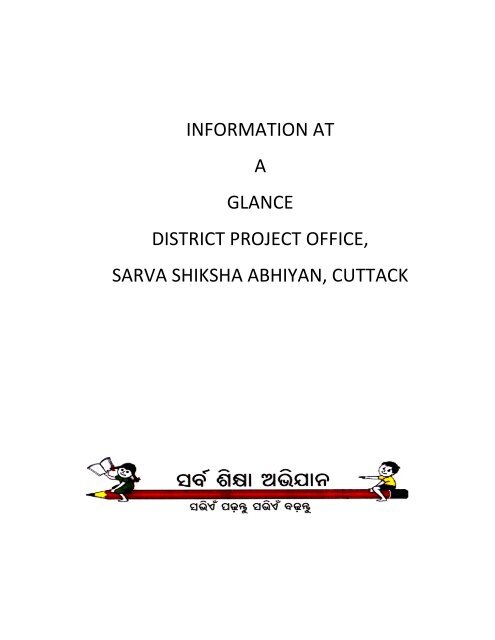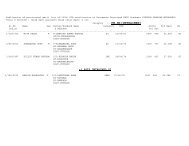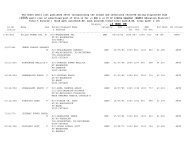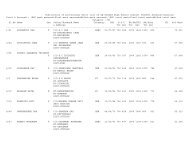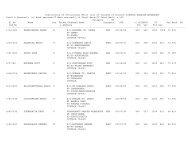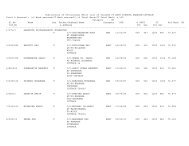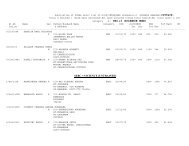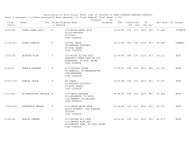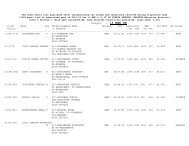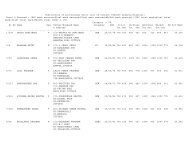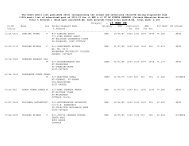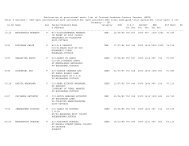INFORMATION AT A GLANCE DISTRICT PROJECT ... - Cuttack
INFORMATION AT A GLANCE DISTRICT PROJECT ... - Cuttack
INFORMATION AT A GLANCE DISTRICT PROJECT ... - Cuttack
You also want an ePaper? Increase the reach of your titles
YUMPU automatically turns print PDFs into web optimized ePapers that Google loves.
<strong>INFORM<strong>AT</strong>ION</strong> <strong>AT</strong><br />
A<br />
<strong>GLANCE</strong><br />
<strong>DISTRICT</strong> <strong>PROJECT</strong> OFFICE,<br />
SARVA SHIKSHA ABHIYAN, CUTTACK
Complete Identity of the Department along<br />
with Generic Postal Address, Fax, Phone No &<br />
E-mail of the Dept.<br />
District Project Office,<br />
Sarva Shiksha Abhiyan, Collectorate, <strong>Cuttack</strong>.<br />
Fax & Phone: 0671 – 2609934 / 2609937<br />
E-mail: dpc.cuttack@opepa.in / cuttack.mis@opepa.in
AIMS, OBJECTIVES & RESPONSIBILITIES<br />
SARVA SHIKSHA ABHIYAN<br />
INTRODUCTION:<br />
Sarva Shiksha Abhiyan is an effort to universalise elementary education by community-ownership of<br />
the school system. It is a response to the demand for quality basic education all over the country. The SSA<br />
programme is also an attempt to provide an opportunity for improving human capabilities to all children,<br />
through provision of community-owned quality education in a mission mode.<br />
WH<strong>AT</strong> IS SARVA SHIKSHA ABHIYAN?<br />
• A programme with a clear time frame for universal elementary education.<br />
• A response to the demand for quality basic education all over the country.<br />
• An opportunity for promoting social justice through basic education.<br />
• An effort at effectively involving the Panchayati Raj Institutions, School Management Committees,<br />
Village and Urban Slum level Education Committees, Parents' Teachers' Associations, Mother Teacher<br />
Associations, Tribal Autonomous Councils and other grass root level structures in the management of<br />
elementary schools.<br />
• An expression of political will for universal elementary education across the country.<br />
• A partnership between the Central, State and the local government.<br />
• An opportunity for States to develop their own vision of elementary education<br />
OBJECTIVES OF SARVA SHIKSHA ABHIYAN<br />
• All children in school, Education Guarantee Centre, Alternate School, ' Back-to-School' camp by 2003;<br />
• All children complete five years of primary schooling by 2007 .<br />
• All children complete eight years of elementary schooling by 2010 .<br />
• Focus on elementary education of satisfactory quality with emphasis on education for life .<br />
• Bridge all gender and social category gaps at primary stage by 2007 and at elementary education<br />
level by 2010.<br />
• Universal retention by 2010.<br />
ORGANIS<strong>AT</strong>IONAL STRUCTURE:<br />
District Project Office, SSA, <strong>Cuttack</strong> is under the administrative control of OPEPA (Orissa Primary<br />
Educational Programme Authority) . Near about 55 Contractual Employees are working under the control of<br />
District Project Office.<br />
Funding Pattern of SSA:<br />
The ratio of funding for SSA Programme by Govt. of India and Govt. of Orissa is as follows:<br />
During 9th Plan (up to march 2002) GOI GOO 85% 15% respectively.<br />
During 10th Plan (from 2002-2007) 75% 25%<br />
From 11th plan onwards (from March 2007) 50% 50%
ORGANIS<strong>AT</strong>ION STRUCTURE, INCLUDING<br />
AGENCIES, DIRECTORIES ETC.<br />
Sl.<br />
No.<br />
Name<br />
1 Additional<br />
Director<br />
(General)<br />
2 Additional<br />
Director<br />
(Planning)<br />
ADMINISTR<strong>AT</strong>IVE STRUCTURE<br />
Name of the activities/Interventions<br />
- Establishment<br />
- Service Matter/Recruitment<br />
- Text Book<br />
- Court Cases<br />
- Uniform<br />
- Teacher Appointment<br />
- PIO<br />
- House Committee<br />
- Assembly Question<br />
- Printing Work<br />
- Management of SIEM<strong>AT</strong><br />
- Rajya Sabha / Lok Sabha Question<br />
- Additional Reading Material<br />
- Community Mobilization<br />
- IED<br />
- KGBV<br />
- Mid Day Meal<br />
- School Sanitation Hygiene Education<br />
- Media<br />
- Planning and Management<br />
- Joint Review Mission<br />
- MIS (DISE, CTS, GIS. EPIS, IMIS, Data Sharing and Capacity Building, All Presentations,<br />
MIS Activities, Computer Aided Learning (System), Reporting and Documentation, HW,<br />
SW & Network Maintenance of SPO & DPO, Roll out of NIC portal)<br />
- Research, Evaluation, Monitoring and Supervision<br />
3 FA & CAO - Finance and Management<br />
4 Deputy Director<br />
(Pedagogy)<br />
- Audit<br />
- Pedagogical Improvement (SIG, TLM, RMG, Quality Monitoring, BRC, CRC, Curriculum,<br />
Textbook revision, Remedial Teaching etc.)<br />
- Computer Aided Learning (Quality)<br />
5 Deputy Director - In-service training, Induction training, Training for un-trained teachers, Training of
(TT)<br />
6 Joint Director<br />
(AS)<br />
7 Deputy Director<br />
(Girls Education)<br />
8 State Project<br />
Engineer<br />
Resource Person, Preparation of training materials<br />
- SC & ST Education<br />
- Distance Education<br />
- Access and Alternative Schooling<br />
- Opening up of new Schools (Primary and Upper Primary Up gradation)<br />
- Innovation<br />
- Girls Education<br />
- NPEGEL<br />
- ECCE<br />
- Civil Work Related to SSA, DPEP, NPEGEL and KGBV<br />
- State Project Office Maintenance<br />
OPEPA (SPO)- ADMINISTR<strong>AT</strong>IVE STRUCTURE
DPO – STRUCTURE<br />
ST<strong>AT</strong>E <strong>PROJECT</strong> DIRECTOR, OPEPA, BHUBANESWAR<br />
District Project Coordinator, DPO, SSA, CUTTACK<br />
Sr. TC FC<br />
Programmer Planning Coordinator<br />
IE Coordinator<br />
SC & ST Coordinator<br />
Pedagogy Coordinator<br />
Gender Coordinator<br />
15 Nos of TC Cashier Accountant 4 Nos of DEOs at DPO &<br />
4Nos at DIs<br />
15 Nos of BRT<br />
Administrative Structure of DPO is as above long with 2Nos. of Programme Assistant,<br />
2Nos of Office Assistant, One Steno & 4Nos of Class-IV employees.
Their Duties & Responsibilities are as follows:<br />
1. Preparing Annual Works Plan & Budget every Year.<br />
2. Conducting Training Programmes.<br />
3. Managing Different types of Data Like DISE, CTS, EPIS, WEB PORTAL etc.<br />
4. Identifying the CWSN Children in the age group of 6-14 age.<br />
5. Providing all types of qualitative & Quantitative support to the Govt & Govt Aided Teachers.<br />
6. Specific Identification of Girls Children, Providing Girls’ Uniform.<br />
7. Supervision & Monitoring of Construction of Building.<br />
These posts are on contractual basis renewable annually and will continue till continuance of the<br />
Project.<br />
Details of Duties & Responsibilities:<br />
a. Scope of Work:<br />
He/She has been engaged in the post as per his/her qualification and specific<br />
nature of job has been assigned to him / her.<br />
He / She shall take up any work / assignment given to him / her of the respective<br />
intervention / branch.<br />
He/She shall develop strategies and ensure effective implementation of the<br />
programme of the concerned interventiuon / branch.<br />
He/She shall undertake any additional duties assigned to him / her for the interest<br />
of the programme.<br />
His / her performance will be reviewed by the competent authority as and when<br />
required.<br />
b. Term of engagement:<br />
This term of engagement will be for one year and will commence from joining till one<br />
year. The engagement can be extended further on one year basis subject to the<br />
following condition.<br />
His / Her performance is found to be satisfactory.<br />
He / She has cleared all personal advance received / granted by OPEPA at the time<br />
of proceeding one month of the end of the last tenure of engagement before<br />
further extension.
Directory of Officers & Employees of District Project Office, Sarva Siksha Abhiyan, <strong>Cuttack</strong><br />
Sl.<br />
No.<br />
1<br />
Name & Designation of the Employee Designation Phone / Mobile No.<br />
Bijay Ku. Rath((OAS(I))<br />
Chittaranjan Panda<br />
District Project Officer,SSA,<br />
<strong>Cuttack</strong><br />
9437516381<br />
IE Coordinator 9861092871<br />
2 Manasi Dhal Girls Education Coordinator 9437103278<br />
3 Hiramani Mohanty Computer Programmer 9437192554<br />
4 Susanta ku. Rout Pedagogy Coordinator 9437784223<br />
5 Manaswini Pradhan Planning Coordinator 9853480536<br />
6 Deepak Ku. Sarangi Financial Coordinator 9437141154<br />
7 Ashok Ku. Upadhyaya Senior Technical Consultant 9437265855<br />
8 Asutosh Mohanty SC / ST Coordinator<br />
9 Sibabrata Behera Accountant 9937997137<br />
10 Santosh ku. Sahoo Junior Steno 9937761761<br />
11 Prajati Mishra Cashier 9937310459<br />
12 Sampurnananda Panda Data Entry Operator 9937607653<br />
13 Bihi Prasad Mohapatra Data Entry Operator 9338124041<br />
14 Sumana Satpathy Data Entry Operator 9937567274<br />
15 Bagmi Dash Data Entry Operator 9437905279<br />
16 Md. Khalid Programme Assistant NIL<br />
17 Kishore Ku. Sahoo Programme Assistant NIL<br />
18 Susmita Mishra Office assistant 9778145302<br />
19 Pradeep Ku. Jena Office assistant NIL<br />
20 Pradipta Ku. Mohapatra Technical Consultant NIL<br />
21 Rabinarayan Sahoo Technical Consultant 9437248192<br />
22 Sushree Sarita Sarangi Technical Consultant 9437332344<br />
23 Guru Prasad Sahoo Technical Consultant 9437315325<br />
24 Nishamani Pradhan Technical Consultant 9437281717<br />
25 Banoj ku. Beura Technical Consultant 9937774421
26 Aseem Mallick Technical Consultant 9338054334<br />
28 Sriram Ch. Tiadi Technical Consultant 9861012033<br />
29 Tapas Khatoi Technical Consultant 9437274037<br />
30 Saroj Ku. Sahoo Technical Consultant 9937054286<br />
31 Pranati Nayak Technical Consultant NIL<br />
32 Subhashree Suchismita Nanda DEO of DI Office 9861862255<br />
33 Ranjit Ku. Bhanjadeo DEO of DI Office NIL<br />
34 Sanghamitra Mohapatra DEO of DI Office 9437635125<br />
35 Ajit Ku. Sabat DEO of DI Office 9040665166<br />
36 Ganeswar Nayak Block Resource Teacher NIL<br />
37 Birndra Ku. Sahoo Block Resource Teacher NIL<br />
38 Kalpana Swain Block Resource Teacher NIL<br />
39 Gayatri Bal Block Resource Teacher NIL<br />
40 Suryanarayan Rath Block Resource Teacher NIL<br />
41 Dinabandhu Dalei Block Resource Teacher NIL<br />
42 Manjulata Bhuyan Block Resource Teacher NIL<br />
43 Anamika Mishra Block Resource Teacher NIL<br />
44 Anandamayee Beura Block Resource Teacher NIL<br />
45 Snigdhamayee Sahoo Block Resource Teacher NIL<br />
46 Swarnaprava Dei Block Resource Teacher NIL<br />
47 Bidyadhar Behera Block Resource Teacher NIL<br />
48 Dipteemayee Routray Block Resource Teacher NIL<br />
49 Sabiyta Ku. Panda Block Resource Teacher NIL<br />
50 Sasmita Pattnaik Block Resource Teacher NIL<br />
51 Santosh Dash Peon NIL<br />
52 M.Manoj Kumar Peon NIL<br />
53 Chidananda Behera Peon NIL<br />
54 Bholanath D. Nayak Night Watch man NIL
FINANCIAL NORMS UNDER SARVA SHIKSHA ABHIYAN<br />
• The assistance under the programme of Sarva Shiksha Abhiyan will be on a 85:15 sharing<br />
arrangement during the IX Plan, 75:25 sharing arrangement during the X Plan, and 50:50 sharing<br />
thereafter between the Central government and State governments. Commitments regarding sharing<br />
of costs would be taken from State governments in writing.<br />
• The State governments will have to maintain their level of investment in elementary education as in<br />
1999-2000. The contribution as State share for SSA will be over and above this investment.<br />
• The Government of India would release funds to the State Governments/Union Territories only and<br />
instalments (except first) would only be released after the previous instalments of Central<br />
government and State share has been transferred to the State Implementation Society.<br />
• The support for teacher salary appointed under the SSA programme could be shared between the<br />
Central Government and the State government in a ratio of 85:15 during the IX Plan, 75:25 during<br />
the X Plan and 50:50 thereafter.<br />
• All legal agreements regarding externally assisted projects will continue to apply unless specific<br />
modifications have been agreed to, in consultation with foreign funding agencies.<br />
• Existing schemes of elementary education of the Department (except National Bal Bhawan and NCTE)<br />
will converge after the IX Plan. The National Programme for Nutritional Support to Primary Education<br />
(Mid-Day-Meal) would remain a distinct intervention with foodgrains and specified transportation<br />
costs being met by the Centre and the cost of cooked meals being met by the State government.<br />
• District Education Plans would inter–alia, clearly show the funds/resource available for various<br />
components under schemes like PMGY, JGSY, PMRY, Sunishchit Rozgar Yojana, Area fund of<br />
MPs/MLAs, State Plan, foreign funding (if any) and resources generated in the NGO sector.<br />
• All funds to be used for upgradation, maintenance, repair of schools and Teaching Learning<br />
Equipment and local management to be transferred to VECs/ School Management Committees/ Gram<br />
Panchayat/ or any other village/ school level arrangement for decentralisation adopted by that<br />
particular State/UT. The village/ school-based body may make a resolution regarding the best way of<br />
procurement.<br />
• Other incentive schemes like distribution of scholarships and uniforms will continue to be funded<br />
under the State Plan. They will not be funded under the SSA programme.<br />
The major financial norms under SSA are:<br />
NORMS FOR INTERVENTIONS UNDER SSA<br />
INTERVENTION<br />
NORM<br />
1. Teacher • One teacher for every 40 children in Primary and upper<br />
primary<br />
• At least two teachers in a Primary school<br />
• One teacher for every class in the upper primary<br />
2. School / Alternative schooling facility Within one Kilometre of every habitation<br />
Provision for opening of new schools as per State norms<br />
or for setting up EGS like schools in unserved<br />
habitations.<br />
3. Upper Primary schools/ Sector As per requirement based on the number of children<br />
completing primary education, up to a ceiling of one<br />
upper primary school/section for every two primary<br />
schools<br />
4. Classrooms Ø A room for every teacher in Primary & upper<br />
Primary, with the provision that there would be two<br />
class rooms with verandah to every Primary school with<br />
at least two teachers.
A room for Head-Master in upper Primary<br />
school/section<br />
5. Free textbooks To all girls/SC/ST children at primary & upper primary<br />
level within an upper ceiling of Rs. 150/- per child<br />
State to continue to fund free textbooks being currently<br />
provided from the State Plans.<br />
6. Civil works Ceiling of 33% of SSA programme funds.<br />
For improvement of school facilities, BRC/CRC<br />
construction.<br />
CRCs could also be used as an additional room.<br />
No expenditure to be incurred on construction of office<br />
buildings<br />
Districts to prepare infrastructure Plans.<br />
7. Maintenance and repair of school<br />
buildings<br />
Only through school management committees/VECs<br />
Upto Rs. 5000 per year as per specific proposal by the<br />
school committee.<br />
Must involve elements of community contribution<br />
8. Upgradation of EGS to regular school<br />
or setting up of a new Primary school<br />
as per State norm<br />
Provision for TLE @ Rs 10,000/- per school<br />
TLE as per local context and need<br />
Involvement of teachers and parents necessary in TLE<br />
selection and procurement<br />
VEC/ school-village level appropriate body to decide on<br />
best mode of procurement<br />
Requirement of successful running of EGS centre for<br />
two years before it is considered for upgradation.<br />
Provision for teacher & classrooms.<br />
9. TLE for upper-primary @ Rs 50,000 per school for uncovered schools.<br />
As per local specific requirement to be determined by<br />
the teachers/ school committee<br />
School committee to decide on best mode of<br />
procurement, in consultation with teachers<br />
School Committee may recommend district level<br />
procurement if there are advantages of scale.<br />
10. Schools grant Rs. 2000/- per year per primary/upper primary school<br />
for replacement of non functional school equipment<br />
Transparency in utilisation<br />
To be spent only by VEC/SMC<br />
11. Teacher grant Rs 500 per teacher per year in primary and upper<br />
primary<br />
Transparency in utilisation<br />
12. Teacher training Provision of 20 days In-service course for all teachers<br />
each year, 60 days refresher course for untrained<br />
teachers already employed as teachers, and 30 days
orientation for freshly trained recruits @ Rs. 70/- per<br />
day<br />
Unit cost is indicative; would be lower in non residential<br />
training programmes<br />
Includes all training cost<br />
Assessment of capacities for effective training during<br />
appraisal will determine extent of coverage.<br />
Support for SCERT/DIET under existing Teacher<br />
Education Scheme<br />
13. State Institute of Educational<br />
Management and Training (SIEM<strong>AT</strong>)<br />
One time assistance up to Rs. 3 crore<br />
States have to agree to sustain<br />
Selection criteria for faculty to be rigorous<br />
14. Training of community leaders For a maximum of 8 persons in a village for 2 days in a<br />
year - preferably women<br />
@ Rs. 30/- per day<br />
15. Provision for disabled children Upto Rs. 1200/- per child for integration of disabled<br />
children, as per specific proposal, per year<br />
District Plan for children with special needs will be<br />
formulated within the Rs. 1200 per child norm<br />
Involvement of resource institutions to be encouraged<br />
16. Research, Evaluation, supervision and<br />
monitoring<br />
Upto Rs. 1500 per school per year<br />
Partnership with research and resource institutions,<br />
pool of resource teams with State specific focus<br />
Priority to development of capacities for appraisal and<br />
supervision through resource/research institutions and<br />
on an effective EMIS<br />
Provision for regular school mapping/micro planning for<br />
up dating of household data<br />
By creating pool of resource persons, providing travel<br />
grant and honorarium for monitoring, generation of<br />
community-based data, research studies, cost of<br />
assessment and appraisal terms & their field activities,<br />
classroom observation by resource persons<br />
Funds to be spent at national, state, district, sub<br />
district, school level out of the overall per school<br />
allocation.<br />
Rs. 100 per school per year to be spent at national level<br />
Expenditure at State/district/BRC/CRC/ School level to<br />
be decided by State/UT, This would include expenditure<br />
on appraisal, supervision, MIS, classroom observation,<br />
etc. Support to SCERT over and above the provision<br />
under the Teacher Education scheme may also be<br />
provided.<br />
Involvement of resource institutions willing to<br />
undertake state specific responsibilities<br />
17. Management Cost Not to exceed 6% of the budget of a district plan<br />
To include expenditure on office expenses, hiring of<br />
experts at various levels after assessment of existing
manpower, POL, etc.;<br />
Priority to experts in MIS, community planning<br />
processes, civil works, gender, etc. depending on<br />
capacity available in a particular district<br />
Management costs should be used to develop effective<br />
teams at State/ District/Block/Cluster levels<br />
Identification of personnel for BRC/CRC should be a<br />
priority in the pre-project phase itself so that a team is<br />
available for the intensive process based planning.<br />
18. Innovative activity for girls' education,<br />
early childhood care & education,<br />
interventions for children belonging to<br />
SC/ST community, computer education<br />
specially for upper primary level<br />
19. Block Resource Centres/ Cluster<br />
Resource Centres<br />
Upto to Rs. 15 lakh for each innovative project and Rs.<br />
50 lakh for a district per year will apply for SSA<br />
ECCE and girls education interventions to have unit<br />
costs already approved under other existing schemes.<br />
BRC/CRC to be located in school campus as far as<br />
possible.<br />
Rs. 6 lakh ceiling for BRC building construction<br />
wherever required<br />
Rs. 2 lakh for CRC construction wherever required -<br />
should be used as an additional classroom in schools.<br />
Total cost of non-school (BRC and CRC) construction in<br />
any district should not exceed 5% of the overall<br />
projected expenditure under the programme in any<br />
year.<br />
Deployment of up to 20 teacher in a block with more<br />
than 100 schools; 10 teachers in smaller Blocks in<br />
BRCs/CRCs.<br />
Provision of furniture, etc. @ Rs. 1 lakh for a BRC and<br />
Rs. 10,000 for a CRC<br />
Contingency grant of Rs. 12,500 for a BRC and Rs.<br />
2500 for a CRC, per year<br />
Identification of BRC/CRC personnel after intensive<br />
selection process in the preparatory phase itself.<br />
20. Interventions for out of school children As per norms already approved under Education<br />
Guarantee Scheme & Alternative and Innovative<br />
Education, providing for the following kind of<br />
interventions<br />
Setting up Education Guarantee Centres in unserved<br />
habitations<br />
Setting up other alternative schooling models<br />
Bridge Courses, remedial courses, Back-to-School<br />
Camps with a focus on mainstreaming out of school<br />
children into regular schools.<br />
21. Preparatory activities for microplanning,<br />
household surveys, studies, community<br />
mobilization, school-based activities,<br />
office equipment, training and<br />
orientation at all levels, etc.<br />
As per specific proposal of a district, duly recommended<br />
by the State. Urban areas, within a district or<br />
metropolitan cities may be treated as a separate unit<br />
for planning as required.


